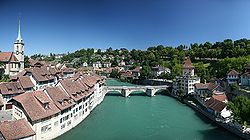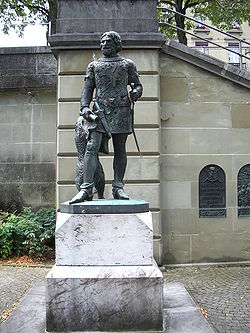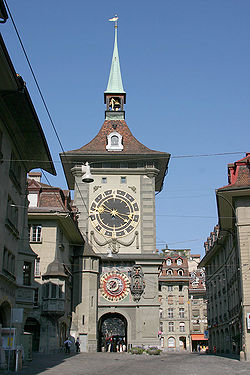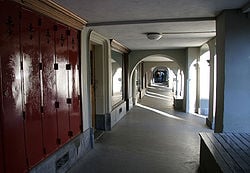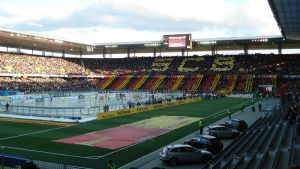Difference between revisions of "Berne" - New World Encyclopedia
Mike Butler (talk | contribs) |
Mike Butler (talk | contribs) |
||
| Line 178: | Line 178: | ||
[[Category:Cities]] | [[Category:Cities]] | ||
| − | {{credit|Berne|228980371|}} | + | {{credit|Berne|228980371|History_of_Berne|212817675|}} |
Revision as of 00:54, 2 August 2008
| Berne | ||||||||||
|---|---|---|---|---|---|---|---|---|---|---|
| ||||||||||
| Population | 128,041 (2007) | |||||||||
| - Density | Expression error: Unrecognized punctuation character ",". /km² (Expression error: Unrecognized punctuation character ",". /sq.mi.) | |||||||||
| Area | 51.6 km² (19.9 sq mi) | |||||||||
| Elevation | 542 m (1,778 ft) | |||||||||
| - Highest | 674 m - Könizberg | |||||||||
| - Lowest | 480 m - Aar | |||||||||
| Aerial view of the Old City of Berne. | ||||||||||
| Postal code | 3000 | |||||||||
| SFOS number | 0351 | |||||||||
| Mayor (list) | Alexander Tschäppät (as of 2008) SPS | |||||||||
| Demonym | Berner | |||||||||
| Surrounded by (view map) |
Bremgarten bei Bern, Frauenkappelen, Ittigen, Kirchlindach, Köniz, Mühleberg, Muri bei Bern, Neuenegg, Ostermundigen, Wohlen bei Bern, Zollikofen | |||||||||
| Twin towns | Salzburg (Austria) | |||||||||
| Website | www.bern.ch | |||||||||
The city of Berne or Bern, French: Berne [bɛʀn], Italian: Berna [ˈbɛrna], Romansh: Berna [ˈbɛrnə], Bernese German: Bärn [b̥æːrn]) is the Bundesstadt (federal city, de facto capital) of Switzerland.
Illustrious Bernese include the reformer Albrecht von Haller, the poet Albert Bitzius and the painters Hans Fries, Ferdinand Hodler and Paul Klee. The German-born physicist Albert Einstein worked out his theory of relativity while employed as a clerk at the Berne patent office. A culturally important person was Mani Matter, a songwriter performing in Bernese German.
Geography
Berne lies in the Swiss plateau part of the Canton of Berne, somewhat west of the center of Switzerland and 12 miles (20km) north of the Alps. The landscape around Berne was formed by glaciers in the last ice age. The two mountains closest to Berne are the Gurten, with a height of 2814 feet (858 meters), and the Bantiger, with a height of 3106 feet (947 meters). The site of the old observatory in Berne is the origin (600 000/200 000) of the CH1903 coordinate system.
Berne has a temperate climate, with cold, cloudy, rainy/snowy winters averaging 28.4°F (-2°C) in January, and cool to warm, cloudy, humid summers, averaging 62.6°F (17°C) in July, with occasional showers. Total annual precipitation is 39.5 inches (1005mm).
The city was originally built on a mountain engulfed by the river Aar but outgrew the natural boundaries of the river in the 19th century. Three bridges were built to allow the city to grow outside of the boundaries imposed by the river: Nydeggbrücke at the east end in 1844, Kirchenfeldbrücke at the south side in 1883, and Kornhausbrücke at the north side in 1898.
The city is built on very uneven ground. There are several dozens of meters in height difference from the quarters down at the Aar (e.g. Matte, Marzili) to the higher ones (e.g. Kirchenfeld, Länggasse).
Size – land area, size comparison
Environmental issues Districts
History
Duke Berchtold V of Zähringen founded the city on the River Aare in 1191 and allegedly named it after a bear (Bär in German) he had killed. It was made an Imperial Free City by the Holy Roman Emperor Frederick II in 1218 after Berthold died without an heir. In 1353 Berne joined the young Swiss Confederation, becoming a leading member of the new state. It invaded and conquered Aargau in 1415 and Vaud in 1536, as well as other smaller territories, thereby becoming the largest city-state north of the Alps. It was occupied by French troops in 1798 during the French Revolutionary Wars, when it was stripped of most of its territories. In 1831 the city became the capital of the Canton of Berne and in 1848 it additionally became the Swiss capital.
The city grew out towards the west of the boundaries of the peninsula formed by the river Aar. Initially, the Zytglogge tower marked the western boundary of the city from 1191 until 1256, when the Käfigturm took over this role until 1345, which, in turn, was then succeeded by the Christoffelturm (located close to today's train station) until 1622. During the time of the Thirty Years' War two new fortifications, the so-called big and small Schanze (entrenchment), were built to protect the whole area of the peninsula. The protection by these edifices was sufficient for the prosperous growth of the city of Berne up to the 19th century.
A number of congresses of the socialist First and Second Internationals were held in Berne, particularly during World War I when Switzerland was neutral. (See Berne International.)
Politics
Berne is governed by an 80-member legislative council (Stadtrat) and a 5-member executive council (Gemeinderat).
As of 2005, the representatives of the Social Democratic Party and of the three Green parties hold a majority in both councils (3 to 2 and 43 to 37, respectively). For this reason, it is they, collectively referred to as "Red-Green-Center" (Rot-Grün-Mitte), who mostly determine City policy, although no formal coalition agreement exists and, under the system of direct democracy that prevails in Switzerland, most important issues are settled by general referendum. The other major political parties of Berne are the Free Democratic Party (FDP, free-market liberal) and the Swiss People's Party (SVP, nationalist, conservative).
The office of mayor (Stadtpräsident), as a primus inter pares (first among equals) in the executive council, is mostly representative. As of 2005, the mayor of Berne is Alexander Tschäppät of the Social Democrats.
Berne also functions as the capital of the Canton of Berne, the second most populous of Switzerland's cantons.
Economy
Overview – Any specialization: For instance, is a manufactured product is associated with particular cities a. Milwaukee—cheese and beer b. Los Angeles—entertainment industry c. Sheffield—coal d. top 20 cities in the U.S. are highly specialized
Per capita GDP, rank Financial and business services sector Tourism Manufacturing Transport: Road, rail, air, sea
Berne is well connected to other cities by several highways (A1, A12, A6).
Public transport works well in Bern, with tram and bus lines which connect the different parts of the City. Bern Rail Station connects the City to the national and international train network. A funicular leads from the Marzili quarter to the Bundeshaus. This funicular is, with a length of 106 m, the shortest public railway in Europe.[1] Several Aar bridges connect the old parts of the city with the newer quarters outside of the peninsula.
Berne is served by Berne Airport, located outside the city near the village of Belp. The regional airport, colloquially called Bern-Belp or Belpmoos, is connected to several Swiss and European cities.
Demography
With a 2007 population of 128,041 people (agglomeration: 344,000), the fifth most populous city in Switzerland (after Zürich, Geneva, Basel and Lausanne).
Race/ethnicity - historical background of ethnic groups
Most of Berne's residents speak German, or more specifically, Bernese German, which is a high-Alemannic dialect. Very few people still speak the Mattenenglisch, a language game used in the former workers' quarter of Matte, but several words have found their way into Bernese German.
Religion
Berne has a University, a University of Applied Science and several vocational schools. The University of Berne is spread over several buildings which are mainly located in the Länggasse quarter.
Of interest
Berne's city center is largely medieval and has been recognised by UNESCO as a Cultural World Heritage Site. Perhaps its most famous sight is the Zytglogge, an elaborate medieval clock tower with moving puppets. It also has an impressive 15th century Gothic cathedral, the Münster, and a 15th century town hall. Thanks to 6 kilometers of arcades, the old town boasts one of the longest covered shopping promenades in Europe.
Since the 16th century, the city has had a bear pit (the Bärengraben), which can be visited off the far end of the Nydeggbrücke. The Federal Palace (Bundeshaus), dating from 1902, which houses the national parliament and part of the federal administration, can also be visited.
Einstein lived in an apartment at the Kramgasse 49, the site of the Einsteinhaus, from 1903 to 1905, the year in which the Annus Mirabilis Papers were published.
The Garden of Roses (Rosengarten), from where a scenic panorama view of the medieval city core can be enjoyed, is a well-kept Rosary on a hill, converted into a park from a former cemetery in 1913.
Berne's most recent sight is the set of fountains in front of the Federal Palace. It was inaugurated on August 1, 2004.
Berne features many heritage sites of national significance.[2] Apart from the entire Old Town and many sites within it, these include the Bärengraben, the Gewerbeschule Bern (1937), the Eidgenössisches Archiv für Denkmalpflege, the Kirchenfeld mansion district (after 1881), the Thunplatzbrunnen, the Federal Mint building, the Federal Archives, the Swiss National Library, the Historical Museum (1894), Alpine Museum, Museum of Communication and Natural History Museum.
Berne features numerous museums including:
- Museum of Arts
- Art-Hall
- Psychiatry Museum
- Historic Museum
- Natural History Museum
- Alpine Museum
- Einstein House
- Marksmen Museum
Berne is rich of cultural offerings for every taste.
Theaters
- Berne Theatre[1]
- Schlachthaus-theater [2]
- Tojo Theater [3]
- The Theater on the Effinger-Street [4]
- Narrenpack Theater Bern [5]
Movie theaters
Berne has several dozens of movie theaters. As is customary in Switzerland, movies are generally shown in their original language (e.g., English) with subtitling in German and French. Only a small number of screenings are dubbed in German. Program information is available through e.g. the Cineman website.
- Queersicht - Queer Filmfestival, annually held second week of November.
Festivals
- Gurtenfestival [6]
- BeJazz Summer and Winter Festival
- Berner Tanztage
- Internationales Jazzfestival Bern
- Taktlos-Festival
- Queersicht - Queer Filmfestival, annually held second week of November.
- Buskers festival
Fairs
- Zibelemärit - The Zibelemärit (onion market) is an annual fair held on the fourth Monday in November.
Sport
The football team BSC Young Boys is based in Berne at the Stade de Suisse Wankdorf, which also is one of the venues for the European football championship.
SC Bern is the major ice hockey team of Berne who plays at the PostFinance Arena.
Miscellaneous
- The Universal Postal Union is situated in Bern.
- Berne (as "Bern") was featured as one of the scenarios in the original SimCity video game
- Well-known anarchist Mikhail Bakunin died in Berne in 1876.
- The city of New Bern, North Carolina in the USA is named after Berne, having been founded in 1710 by Christoph von Graffenried, a minor Swiss noble from Berne who attempted to set up Swiss settlement in the New World.
External links
- City of Bern
- Bern (Gemeinde) in German, French or Italian in the online Historical Dictionary of Switzerland.
- GIS City of Berne
- Travel guide to Berne from Wikitravel
- Berne Public Transportation Website (BernMobil)
- CityHunter Bern
ReferencesISBN links support NWE through referral fees
- ↑ Marzilibahn (German)
- ↑ Swiss inventory of cultural property of national and regional significance (1995), p. 103–105.
Credits
New World Encyclopedia writers and editors rewrote and completed the Wikipedia article in accordance with New World Encyclopedia standards. This article abides by terms of the Creative Commons CC-by-sa 3.0 License (CC-by-sa), which may be used and disseminated with proper attribution. Credit is due under the terms of this license that can reference both the New World Encyclopedia contributors and the selfless volunteer contributors of the Wikimedia Foundation. To cite this article click here for a list of acceptable citing formats.The history of earlier contributions by wikipedians is accessible to researchers here:
The history of this article since it was imported to New World Encyclopedia:
Note: Some restrictions may apply to use of individual images which are separately licensed.

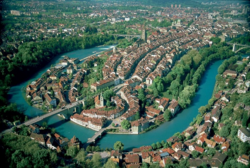
![Berne [zoom] (Switzerland)](/d/images/thumb/c/cf/Karte_Schweiz.png/265px-Karte_Schweiz.png)
